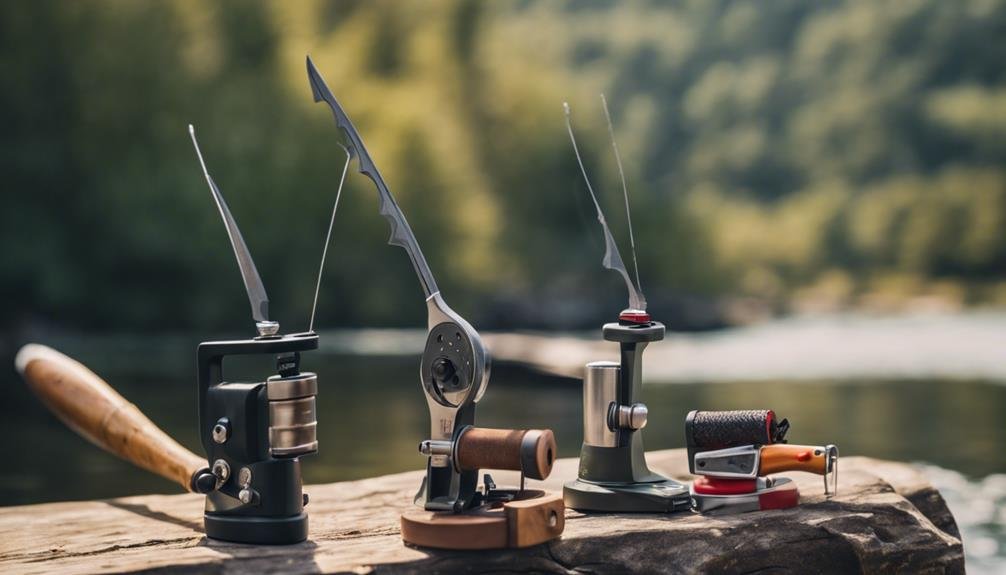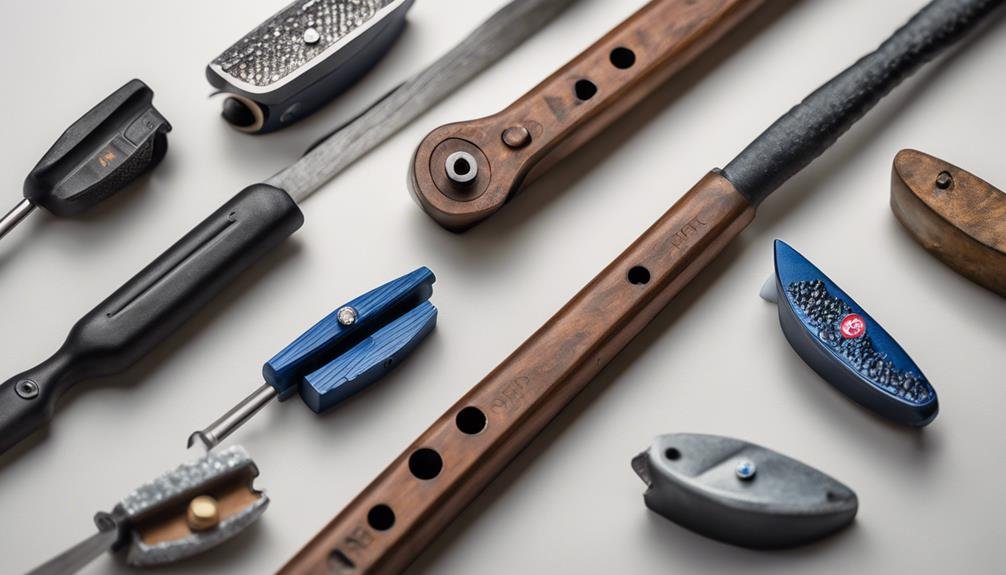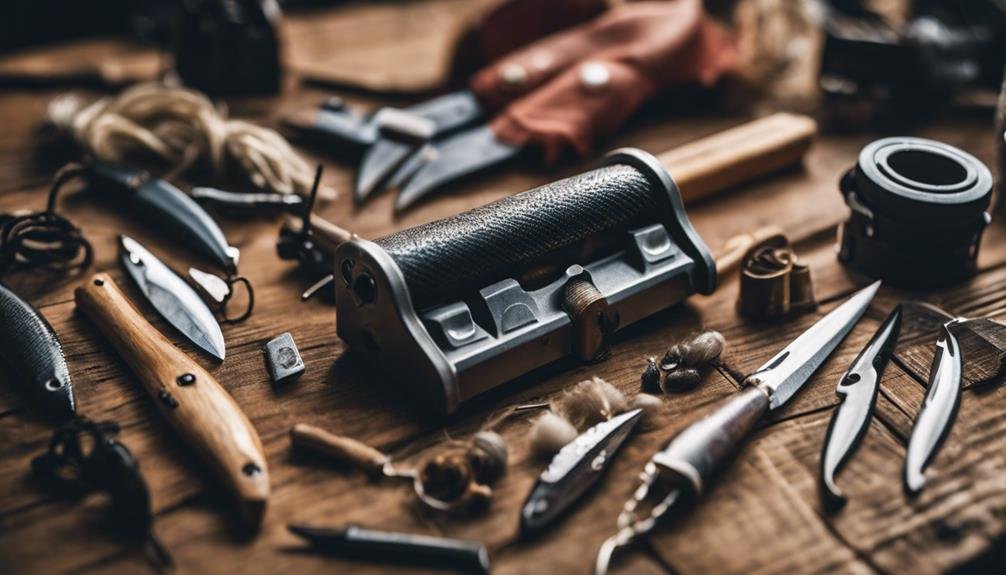When it comes to honing your fishing knives, having the right sharpener can make all the difference. Picture effortlessly slicing through your catch with precision and ease, knowing your tools are in top condition. But how do you navigate the sea of options available to find the perfect fit for your needs? Stay tuned to discover insightful tips on selecting the ideal fishing knife sharpener that will elevate your filleting game to new heights.
Key Takeaways
- Consider the type of knives for the right sharpener.
- Look for multiple stages for coarse and fine sharpening.
- Opt for compact designs with replaceable carbide blades.
- Choose models with lanyard holes for portability.
- Select sharpeners with preset angles for consistent results.
Benefits of Fishing Knife Sharpeners

Regularly sharpening your fishing knives with a dedicated sharpener is vital for maintaining their sharpness and ensuring peak cutting performance. Investing in a quality fishing knife sharpener brings numerous benefits.
By using a fishing knife sharpener, you can prolong the lifespan of your knives as it prevents dullness and damage. Not only does this save you money in the long run by avoiding frequent replacements, but it also enhances your filleting and cutting efficiency. A sharp knife ensures clean and precise cuts, making your fishing experience more enjoyable and productive.
Additionally, the risk of accidents and injuries caused by using dull blades is significantly reduced when you sharpen your fishing knives with a proper sharpener. Incorporating a fishing knife sharpener into your routine maintenance not only keeps your tools in top condition but also enhances your overall fishing experience.
Types of Fishing Knife Sharpeners
When considering types of fishing knife sharpeners, it’s important to evaluate the specific features and benefits that each type offers.
Electric knife sharpeners are convenient and fast, making them ideal for quickly sharpening fishing knives, including delicate fillet knives.
Manual sharpeners, like sharpening stones, provide precision control for anglers who prefer a hands-on approach to sharpening their fillet knives.
Pocket-sized knife sharpeners are portable and suitable for sharpening fishing knives, such as fillet knives, on-the-go, catering to anglers who are always on the move.
Sharpening systems with multiple sharpening stages offer versatility for different levels of blade dullness, ensuring that your fillet knife can be sharpened effectively regardless of its current condition.
Additionally, sharpening rods with built-in angle guides are beneficial for maintaining the correct angle needed for optimal sharpness, particularly essential for fillet knives which require precision sharpening to ensure clean cuts.
How to Choose the Right Sharpener

To select the appropriate sharpener for your fishing knives, consider the type of knives you’ll be sharpening, such as fillet knives or standard fishing knives. Different knives may require specific sharpening techniques, so understanding the type of knife you own is essential.
When choosing a sharpener, look for features like multiple stages for coarse and fine sharpening. These stages accommodate various blade conditions, ensuring a well-sharpened knife every time. Additionally, opt for sharpeners with replaceable carbide blades and compact designs for both portability and durability.
Having a lanyard hole on the sharpener is also beneficial as it allows you to easily attach it to your gear or tackle box for quick access. Finally, selecting a sharpener with preset sharpening angles guarantees consistent and reliable results, making the sharpening process efficient and effective for your fishing knife needs.
Top Features to Look For
When selecting a fishing knife sharpener, prioritize features such as a two-stage design with coarse carbide and fine ceramic rods for the best sharpening results. To guarantee you have the best tool for the job, look for the following top features to make your sharpening experience easy and effective:
- Coarse Carbide and Fine Ceramic Rods: Opt for a sharpener that offers both coarse carbide rods for fixing knicks and bumps, and fine ceramic rods for final honing, providing you with a versatile sharpening solution.
- PTFE Honeycomb Grips and Anti-Slip Finger Guards: Choose a sharpener with these features for a secure grip, making it easy to handle the sharpener without the risk of accidents.
- Lightweight and Compact Design: Select a sharpener that’s lightweight and compact for easy portability and storage, allowing you to take it along on your fishing trips without adding extra bulk to your gear.
Tips for Sharpening Fishing Knives

For best sharpening results, make sure you maintain a consistent 90-degree angle while applying firm pressure to your fishing knife. This technique guarantees that the blade is sharpened evenly, leading to a razor-sharp edge.
Using a two-stage sharpener with coarse carbide rods for initial sharpening and fine ceramic rods for final honing will help achieve that sharpness. Consider investing in the RegalRiver Hook and Knife Sharpener, known for its quick, safe, and easy sharpening process with preset angles to assist you in maintaining the perfect blade angle.
When selecting a fishing knife sharpener, opt for models with reversible and replaceable carbide blades for durability. These features ensure a long-lasting tool that can keep your fishing knives razor sharp. Look for compact designs with lanyard holes, as they’re portable and suitable for sharpening various sizes of fish hooks and knives, making them convenient for all your fishing needs.
Maintenance and Care Tips
After honing your fishing knives to perfection, guaranteeing proper maintenance and care of your sharpener is key to preserving its longevity and effectiveness. Here are three essential maintenance and care tips to keep your fishing knife sharpener in top condition:
- Regular Cleaning: Keep your sharpener clean by wiping it with a damp cloth to remove any dirt or debris that may accumulate during use. This simple step can prevent buildup and maintain the sharpener’s performance.
- Proper Storage: Store the sharpener in a dry place, preferably in your tackle box, to prevent rust or corrosion on the blades. Protecting it from moisture and extreme temperatures will help prolong its lifespan.
- Check for Wear: Periodically inspect the sharpening rods for any signs of wear or damage. If you notice any issues, consider replacing the rods to ensure consistent and effective sharpening.
Conclusion
So, next time you head out for a fishing trip, make sure you have a quality fishing knife sharpener on hand. By investing in a sharpener and following the tips for maintenance and care, you can guarantee your knives are always ready for the job.
With sharp, efficient knives, you’ll be able to fillet your catch with ease and enjoy a smoother fishing experience overall.
Happy fishing!

